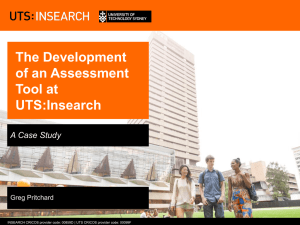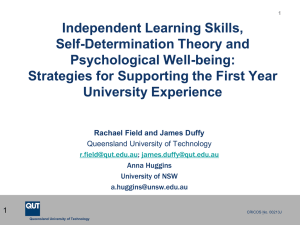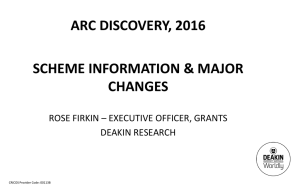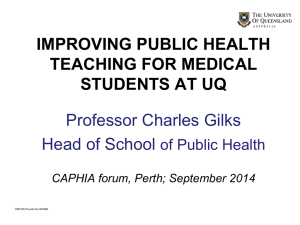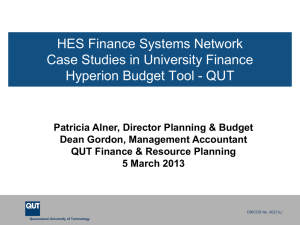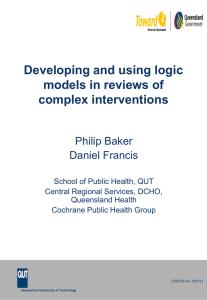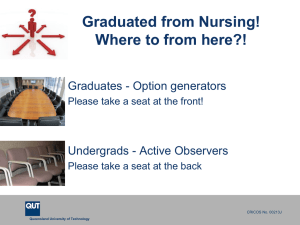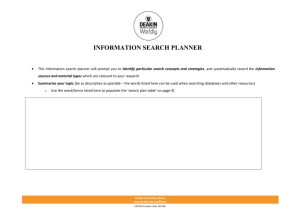Cycling interventions and cost - effectiveness
advertisement
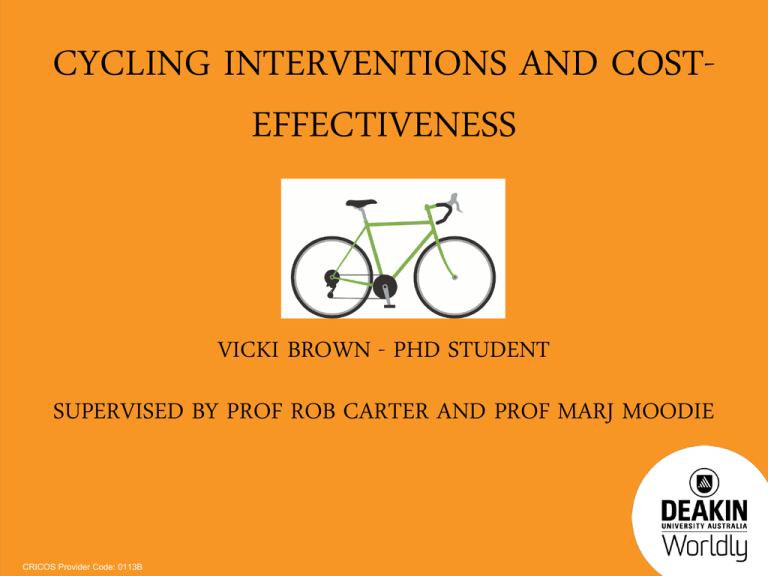
CYCLING INTERVENTIONS AND COSTEFFECTIVENESS VICKI BROWN - PHD STUDENT SUPERVISED BY PROF ROB CARTER AND PROF MARJ MOODIE CRICOS Provider Code: 0113B CONTENTS 1. What we know: – Cycling and health – Effectiveness and cost-effectiveness 2. What I am planning to do: –Incorporating health effects related to change in physical activity into transport appraisal. CRICOS Provider Code: 0113B 1. WHAT WE KNOW CRICOS Provider Code: 0113B CYCLING AND HEALTH CRICOS Provider Code: 0113B LIMITED RIGOROUS EVIDENCE EXISTS ON THE EFFECT OF CYCLING INTERVENTIONS Methodological challenges include: – Controlled studies difficult, not feasible – Time periods to observe changes can be long, study time frames often short – Data issues – Other factors influence modal choice CRICOS Provider Code: 0113B WHAT IS NEEDED….. More research into the effect of interventions, attempting to address methodological challenges. CRICOS Provider Code: 0113B METHODS FOR ESTABLISHING COSTEFFECTIVENESS Transport appraisal Health evaluation Cost Benefit Analysis (CBA) Cost Effectiveness Analysis (CEA) Costs and benefits in monetary terms Benefits using measures that incorporate both the quality and quantity of life Health – commonly limited to accidents/injuries and environmental effects (pollution, emissions) CRICOS Provider Code: 0113B CAVILL ET AL REVIEW Systematic review: economic evaluations of transport infrastructure and policies incorporating health effects related to physical activity. Interventions mostly cost-effective - some cost-saving. CRICOS Provider Code: 0113B WHO HEALTH ECONOMIC ASSESSMENT TOOL (HEAT)CYCLING HEAT estimates the economic benefit of reduced deaths Adult populations aged 20-64 years Risk of death (mortality) CRICOS Provider Code: 0113B 2. WHAT I PLAN TO DO CRICOS Provider Code: 0113B OBESITY • Approx. 63% of Australian adults now classified as overweight or obese • 1 in 4 Australian children CRICOS Provider Code: 0113B CRE IN OBESITY POLICY Priority Setting & Policy Implementation Policy Impact Monitoring of Actions & Outcomes Stream 1 Stream 2 Stream 3 Stream 4 What are the economic credentials of (nonhealth sector) policy options? CRICOS Provider Code: 0113B How can evidenceinformed policy development & implementation be enhanced and sustained? What are the impacts of policies on environments & systems? What progress is being made by public & private sectors in Australia & internationally? CRE research program Economic Policy process Policy impacts & Monitoring for credentials analysis systems changes accountability of policy options Policy process Scoping & Analysis of Potential Solutions TRANSPORT-RELATED INTERVENTIONS PhD thesis: Economic evaluations of 5 transport-related interventions that may have an impact on physical activity, BMI, obesity. CRICOS Provider Code: 0113B SIGNIFICANCE OF THE RESEARCH CRICOS Provider Code: 0113B UPDATE OF CAVILL REVIEW Systematic review of economic evaluations of transport interventions that include health effects related to change in physical activity. 27 new studies. CRICOS Provider Code: 0113B Transport interventions “Nudge” interventions Behavioural change Education and awareness Social marketing SCOPING • Active transport to school; • Education and social marketing; • Congestion pricing; • Public transport pricing, fuel excise; • Provision of infrastructure. CRICOS Provider Code: 0113B “Push” interventions Structural change Travel planning Infrastructure Economic instruments Legislation Prices Subsidies Taxes CRE METHODOLOGY FOR ASSESSING INTERVENTIONS ACE approach, as utilised in ACE-Obesity and ACE-Prevention projects. Key characteristics: • Standardised evaluation protocol. • Scoping papers to assess potential interventions for modelling • Technical Advisory Panels (TAPs) and expert guidance to provide advice and recommendations • Other factors CRICOS Provider Code: 0113B ECONOMIC METHODS 1. ACE APPROACH Cost-effectiveness analysis (CEA) 2. COST-BENEFIT (CBA) APPROACH WHO HEAT (mortality only) CRE work: methodological challenges of CBA CRICOS Provider Code: 0113B • Comparable • High quality • Transparent Morbidity and mortality CONCLUSION • In-depth analysis of the potential role and impact of transportrelated interventions on obesity prevention. • Contribution to the body of evidence on the physical activity related health effects of transport. • Another step towards routine inclusion of physical activity related health benefits into transport appraisal. CRICOS Provider Code: 0113B THANK-YOU QUESTIONS? CRICOS Provider Code: 0113B REFERENCES 1. 2. 3. 4. 5. 6. 7. 8. Australian Government Department of Infrastructure and Transport. Walking, Riding and Access to Public Transport: Supporting active travel in Australian communities. Canberra: Aust Government . Department of Infrastructure and Transport, 2013. AustRoads, Australian Bicycle Council. National Cycling Strategy, 2011-16. Sydney: AustRoads, 2010. Andersen LB, Schnohr P, Schroll M, Hein HO. All-cause mortality associated with physical activity during leisure time, work, sports, and cycling to work. Archives of internal medicine. 2000;160(11):1621-8. Ogilvie D, Egan M, Hamilton V, Petticrew M. Promoting walking and cycling as an alternative to using cars: systematic review. Brit Med J. 2004;329(7469):763-6B. Pucher J, Dill J, Handy S. Infrastructure, programs, and policies to increase bicycling: An international review. Preventive medicine. 2010;50:S106-S25. Yang L, Sahlqvist S, McMinn A, Griffin SJ, Ogilvie D. Interventions to promote cycling: systematic review. Brit Med J. 2010;341. Cavill N, Kahlmeier S, Rutter H, Racioppi F, Oja P. Economic analyses of transport infrastructure and policies including health effects related to cycling and walking: a systematic review. Transport Policy. 2008;15(5):291-304 World Health Organisation. Development of the health economic assessment tools (HEAT) for walking and cycling, Meeting report of the consensus workshop in Bonn, Germany, 1-2 October 2013. Copenhagen, Denmark: WHO Regional Office for Europe, 2014. CRICOS Provider Code: 0113B CEA Compares costs and outcomes like CBA, but difficulties with monetising health effects so uses utility based measures: • QALY – measure of disease burden including both quantity and quality of life; Perfect health=1, death=0. • DALY – measure of disease burden, no. years lost to disability, death. CRICOS Provider Code: 0113B

